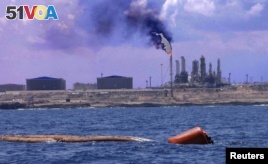October 10,2013
OPEC’s crude oil production fell below 30-million barrels a day in September. That’s the first time that’s happened in more than two years.
There are two main reasons for the drop in OPEC production. John Kingston of Platts says one is a temporary problem, while the other is ongoing and may be more troublesome.

A general view of the port and Zawiya Oil Refinery, west of the city of Tripoli, Libya, Aug. 22, 2013.
“The temporary reason is that there was significant maintenance at some of the Iraqi operations in that month and that’s coming back. And we would expect Iraq production to get back toward its normal level. The one that’s been a lot more troubling – and it wasn’t new to September, though it seemed to pick up pace in September – are all the problems going on in Libya.”
Kingston is global director of news for Platts, a major provider of information about the energy, petrochemical, metals and agricultural sectors. He said that Libya’s crude oil production has fallen because of strikes and protests.
“After Ghadafi fell, the country’s production came back a lot faster than a lot of people expected. You know, they were producing about 1.6-million barrels a day prior to the Ghadafi fall and the (output) of course dropped down to like not much more than zero – and then climbed back smartly. But now these problems that have brought production down below half a million barrels a day, they are a little bit more intractable. And they’re not the kind of things that get fixed overnight. So Libya is clearly an issue for the oil market,” he said.
And Libyan crude is not the type that’s easily replaced.
He said, “The Libyan crude is some of the best crude in the world – some of the top quality. So to replace it on the market what you need to do is you need to produce more of a lesser quality crude. So it’s not a one for one. So this is clearly a source of some problems for the industry.”
Kingston said Libya has used its geographic position in North Africa to its advantage by supplying many refineries in southern France. Without a strong central authority, he said, Libyan crude oil production may remain up and down for a while.
“The kind of analogy is to look at Nigeria, which is always up and down depending on the level of political tension and political strife there. You get a couple of months where they get back up over two-million barrels a day and you think, OK, there we go. They’re on their way. And then a few months later they’ve shaved another several hundred thousand barrels a day of production off their output. So the concern is that Libya will have these months where some fields will come back, but then they can sink right back down,” he said.
The fall in Iraqi and Libyan output was offset somewhat by small production increases in Algeria, Angola, Ecuador, Iran, Nigeria, UAE and Venezuela.
The Platts survey shows that Saudi Arabia, which has boosted output in recent months, remained unchanged in September at 10 million barrels a day.
Kingston said that OPEC’s production rises and falls depending on world demand.
“Right now, almost everybody in that organization is producing full out except for Saudi Arabia. Kuwait and the UAE have some fluctuation, but it’s Saudi Arabia. And the Saudis in the last year or so have fluctuated between a little over 9-million barrels a day and all the way up to 10-million barrels a day. That’s quite a bit of movement in just a year. So they’ve been stepping up to fill some of the gap that has been left by the problems that Libya has had.”
OPEC’s next scheduled meeting is December 4th in Vienna. It currently has an official output ceiling of 30-million barrels a day.